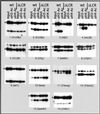The murine beta-globin locus control region regulates the rate of transcription but not the hyperacetylation of histones at the active genes
- PMID: 11553791
- PMCID: PMC58747
- DOI: 10.1073/pnas.201394698
The murine beta-globin locus control region regulates the rate of transcription but not the hyperacetylation of histones at the active genes
Abstract
Locus control regions (LCRs) are defined by their ability to confer high-level tissue-specific expression to linked genes in transgenic assays. Previously, we reported that, at its native site, the murine beta-globin LCR is required for high-level beta-globin gene expression, but is not required to initiate an open chromatin conformation of the locus. To further investigate the mechanism of LCR-mediated transcriptional enhancement, we have analyzed allele-specific beta-globin expression and the pattern of histone acetylation in the presence and absence of the LCR. In single cells from mice heterozygous for a deletion of the LCR, beta-globin expression from the LCR-deleted allele is consistently low ( approximately 1-4% of wild type). Thus, the endogenous LCR enhances globin gene expression by increasing the rate of transcription from each linked allele rather than by increasing the probability of establishing transcription per se. Furthermore, in erythroid cells from mice homozygous for the highly expressing wild-type beta-globin locus, hyperacetylation of histones H3 and H4 is localized to the LCR and active genes. In mice homozygous for the LCR deletion reduced histone hyperacetylation is observed in LCR proximal sequences; however, deletion of the LCR has no effect on the localized hyperacetylation of the genes. Together, our results suggest that, in its native genomic context, the LCR follows the rate model of enhancer function, and that the developmentally specific hyperacetylation of the globin genes is independent of both the rate of transcription and the presence of the LCR.
Figures




Similar articles
-
Nuclear localization and histone acetylation: a pathway for chromatin opening and transcriptional activation of the human beta-globin locus.Genes Dev. 2000 Apr 15;14(8):940-50. Genes Dev. 2000. PMID: 10783166 Free PMC article.
-
The beta -globin locus control region (LCR) functions primarily by enhancing the transition from transcription initiation to elongation.Genes Dev. 2003 Apr 15;17(8):1009-18. doi: 10.1101/gad.1072303. Epub 2003 Apr 2. Genes Dev. 2003. PMID: 12672691 Free PMC article.
-
Activation of beta-major globin gene transcription is associated with recruitment of NF-E2 to the beta-globin LCR and gene promoter.Proc Natl Acad Sci U S A. 2001 Aug 28;98(18):10226-31. doi: 10.1073/pnas.181344198. Epub 2001 Aug 21. Proc Natl Acad Sci U S A. 2001. PMID: 11517325 Free PMC article.
-
Chromatin structure and transcriptional regulation of the beta-globin locus.Exp Cell Res. 2002 Aug 1;278(1):1-11. doi: 10.1006/excr.2002.5555. Exp Cell Res. 2002. PMID: 12126952 Review.
-
ChIPs of the beta-globin locus: unraveling gene regulation within an active domain.Curr Opin Genet Dev. 2002 Apr;12(2):170-7. doi: 10.1016/s0959-437x(02)00283-6. Curr Opin Genet Dev. 2002. PMID: 11893490 Review.
Cited by
-
The locus control region activates serpin gene expression through recruitment of liver-specific transcription factors and RNA polymerase II.Mol Cell Biol. 2007 Aug;27(15):5286-95. doi: 10.1128/MCB.00176-07. Epub 2007 May 25. Mol Cell Biol. 2007. PMID: 17526725 Free PMC article.
-
Flanking HS-62.5 and 3' HS1, and regions upstream of the LCR, are not required for beta-globin transcription.Blood. 2006 Aug 15;108(4):1395-401. doi: 10.1182/blood-2006-04-014431. Epub 2006 Apr 27. Blood. 2006. PMID: 16645164 Free PMC article.
-
Synergistic and additive properties of the beta-globin locus control region (LCR) revealed by 5'HS3 deletion mutations: implication for LCR chromatin architecture.Mol Cell Biol. 2005 Aug;25(16):7033-41. doi: 10.1128/MCB.25.16.7033-7041.2005. Mol Cell Biol. 2005. PMID: 16055715 Free PMC article.
-
Super-enhancers include classical enhancers and facilitators to fully activate gene expression.Cell. 2023 Dec 21;186(26):5826-5839.e18. doi: 10.1016/j.cell.2023.11.030. Epub 2023 Dec 14. Cell. 2023. PMID: 38101409 Free PMC article.
-
A 220-nucleotide deletion of the intronic enhancer reveals an epigenetic hierarchy in immunoglobulin heavy chain locus activation.J Exp Med. 2009 May 11;206(5):1019-27. doi: 10.1084/jem.20081621. Epub 2009 May 4. J Exp Med. 2009. PMID: 19414554 Free PMC article.
References
-
- Bulger M, Groudine M. Genes Dev. 1999;13:2465–2477. - PubMed
-
- Engel J D, Tanimoto K. Cell. 2000;100:499–502. - PubMed
-
- Higgs D R. Cell. 1998;95:299–302. - PubMed
-
- Epner E, Reik A, Cimbora D, Telling A, Bender M A, Fiering S, Enver T, Martin D I, Kennedy M, Keller G, Groudine M. Mol Cell. 1998;2:447–455. - PubMed
Publication types
MeSH terms
Substances
Grants and funding
LinkOut - more resources
Full Text Sources

